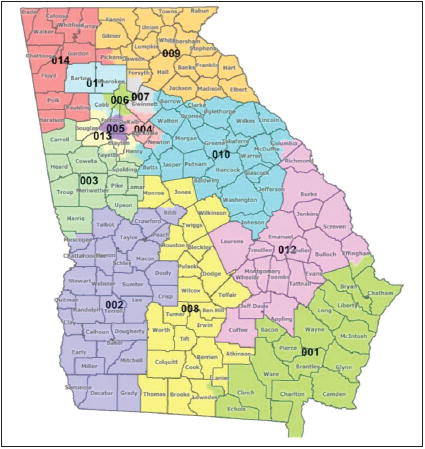Redistricting Facts


Redistricting is the process of drawing new congressional and state legislative district boundaries. Upon completion of the 2020 census, Georgia will draft and enact new district maps. Georgia's 14 United States representatives and 236 state legislators are all elected from political divisions called districts. District lines are redrawn every 10 years following completion of the United States census. Federal law stipulates that districts must have nearly equal populations and must not discriminate on the basis of race or ethnicity. Gina Wright is the Executive Director of the Office of Legislative and Congressional Reapportionment, a nonpartisan joint office of the General Assembly that serves the Senate and the House. She explained the process which will create new or modified districts in Georgia. “As the population in our state grows, the number of people in each district must be adjusted so the population in each district is as close to equal as practicable. This is done by redistricting or modifying the boundary lines of the districts.” In Georgia the new 2020 census resident population total is 10, 711, 908 people. Because of this population increase each of the state’s 14 congressional districts will have to adjust to have 765,136 people in them. At the state level the legislative branch of government has 56 state senators and 180 representatives in the state House elected by districts. “The state senatorial districts will be redrawn to now include around 191, 284 people. State House districts will also need to increase in population size to around 59,511 people,” Wright explained.
Redistricting Committees
In the Georgia General Assembly there is a standing committee on redistricting in both the House and Senate. Each committee has a chairman. In the House, Bonnie Rich, who represents District 97, has served as chairman of the committee since 2019. John F. Kennedy, who represents District 18 in the Senate, is her Senate counterpart.
The following individuals were assigned to the Senate Reapportionment and Redistricting Committee in the 2020 cycle: John F. Kennedy (R), Chairman; Bill Cowsert, (R), Vice Chairman; Jeff Mullis, (R), Ex-Officio; and members, Tonya Anderson, (D), Dean Burke, (R), Gloria Butler, (D), Greg Dolezal, (R), Mike Dugan, (R), Steve Gooch, (R), Marty Harbin, (R), Ed Harbison, (D), Harold V. Jones II, (D), Butch Miller, (R), Michael “Doc” Rhett, (D), and Blake Tillery, (R).
The following individuals were assigned to the House Reapportionment and Redistricting Committee in the 2020 cycle: Bonnie Rich, (R), Chair, Darlene Taylor, (R), Vice Chair, Susan Holmes, (R), Secretary; and members, Richard H. Smith, (R), Lynn Smith, (R), Carl Gilliard, (D), Ed Setzler, (R), Randy Nix, (R), Jan Jones, (R), Mack Jackson, (D), Barry Fleming, (R), Chuck Efstration, (R), Matt Dollar, (R), Kimberly Alexander, (D), Buddy DeLoach, (R), Mandi Ballinger, (R), Sandra Scott, (D), Edward Stephens, (D).
Drafting Process
In Georgia, both congressional and state legislative district lines are drawn by the state legislature. A simple majority in each chamber is required to approve redistricting plans, which are subject to veto by the governor. The Georgia Constitution requires that state legislative districts be contiguous. There are no similar requirements for congressional districts.
In 2011, the House redistricting committee released guidelines recommending the following for both congressional and state legislative districts: 1. prohibition of multimember districts 2. consideration of county and precinct boundaries 3. compactness 4. consideration of communities of interest The committee also suggested that 'efforts should be made to avoid the unnecessary pairing of incumbents' within single districts. These are not legal requirements and as such, they may be altered at any time.
Process Timeline
The U.S. Census Bureau delivered apportionment counts on April 26, 2021. Georgia was apportioned 14 seats in the U.S. House of Representatives. This represented neither a gain nor a loss of seats as compared to apportionment after the 2010 census On February 12, 2021, the Census Bureau announced that it would deliver redistricting data to the states by September 30, 2021. On March 15, 2021, the Census Bureau released a statement indicating it would make redistricting data available to the states in a legacy format in midto- late August 2021. A legacy format presents the data in raw form, without data tables and other access tools. In early June 2021, Georgia lawmakers scheduled a series of public hearings on redistricting. The last hearing was held virtually on July 30.
Wright explained that traditionally the governor calls a special session in late summer or early fall following arrival of the new census data. The sole purpose this session is to adopt newly redrawn maps for all statewide district plans and may also include new maps for local county commissions or school board districts. “The session occurs so that all county election officials will have sufficient time to update voter district assignments once the process is complete prior to elections the next year,” Wright said. After the General Assembly adopts new maps and the governor signs the bills into law, they become the new election districts for use in the next election cycle or on the date specified in the legislation. Because of COVID delays, the special session will take place later than usual.
(Resources: Ballotpedia and the Office of Legislative and Congressional Reapportionment)








